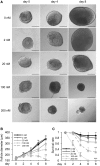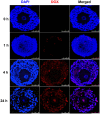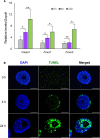Doxorubicin Has Dose-Dependent Toxicity on Mouse Ovarian Follicle Development, Hormone Secretion, and Oocyte Maturation
- PMID: 28329872
- PMCID: PMC6074798
- DOI: 10.1093/toxsci/kfx047
Doxorubicin Has Dose-Dependent Toxicity on Mouse Ovarian Follicle Development, Hormone Secretion, and Oocyte Maturation
Abstract
Doxorubicin (DOX), one of the most commonly used anticancer medications, has been reported to affect fertility by damaging ovarian follicles; however, the dose-dependent toxicity of DOX on the dynamic follicle development and oocyte maturation has not been well-defined. Our objective is to determine the effects of human-relevant exposure levels of DOX on follicular functions across developmental time. In vitro cultured multilayered secondary mouse follicles were treated with DOX at 0, 2, 20, 100, and 200 nM for 24 h, and follicle development, hormone secretion, and oocyte maturation were analyzed. DOX caused dose-dependent toxicity on follicle growth, survival, and secretion of 17β-estradiol (E2). At 200 nM, DOX induced DNA damage and apoptosis in follicle somatic cells first and then in oocytes, which was correlated with the uptake of DOX first to the somatic cells followed by germ cells. Follicles treated with DOX at 0, 2, and 20 nM showed similar oocyte metaphase II (MII) percentages after in vitro oocyte maturation; however, 20 nM DOX significantly increased the number of MII oocytes with abnormal spindle morphology and chromosome misalignment. In an effort to harmonize the in vitro study to in vivo treatment, dose-dependent toxicity on oocyte meiotic maturation was found in 16-day-old CD-1 mice treated with DOX at 0, 0.4, 2, and 10 mg/kg, consistent with the in vitro oocyte maturation outcomes. Our study demonstrates that DOX has dose-dependent toxicity on ovarian follicle development, hormone secretion, and oocyte maturation, which are three key factors to support the female reproductive and endocrine functions.
Keywords: doxorubicin; follicle development; oocyte maturation; ovarian toxicity.
© The Author 2017. Published by Oxford University Press on behalf of the Society of Toxicology. All rights reserved. For Permissions, please e-mail: journals.permissions@oup.com.
Figures







Similar articles
-
A closed vitrification system enables a murine ovarian follicle bank for high-throughput ovotoxicity screening, which identifies endocrine disrupting activity of microcystins.Reprod Toxicol. 2020 Apr;93:118-130. doi: 10.1016/j.reprotox.2020.01.009. Epub 2020 Feb 1. Reprod Toxicol. 2020. PMID: 32017985 Free PMC article.
-
Doxorubicin obliterates mouse ovarian reserve through both primordial follicle atresia and overactivation.Toxicol Appl Pharmacol. 2019 Oct 15;381:114714. doi: 10.1016/j.taap.2019.114714. Epub 2019 Aug 19. Toxicol Appl Pharmacol. 2019. PMID: 31437492 Free PMC article.
-
Doxorubicin-induced toxicity to 3D-cultured rat ovarian follicles on a microfluidic chip.Toxicol In Vitro. 2020 Feb;62:104677. doi: 10.1016/j.tiv.2019.104677. Epub 2019 Oct 16. Toxicol In Vitro. 2020. PMID: 31629067
-
MicroRNAs transfected into granulosa cells may regulate oocyte meiotic competence during in vitro maturation of mouse follicles.Hum Reprod. 2013 Nov;28(11):3050-61. doi: 10.1093/humrep/det338. Epub 2013 Aug 26. Hum Reprod. 2013. PMID: 23980055
-
Ultrastructural and spectroscopic methods in the study of anthracycline-membrane interaction.Pharmacol Res. 1995 Nov;32(5):255-72. doi: 10.1016/s1043-6618(05)80013-1. Pharmacol Res. 1995. PMID: 8868055 Review.
Cited by
-
hUMSC transplantation restores ovarian function in POI rats by inhibiting autophagy of theca-interstitial cells via the AMPK/mTOR signaling pathway.Stem Cell Res Ther. 2020 Jul 3;11(1):268. doi: 10.1186/s13287-020-01784-7. Stem Cell Res Ther. 2020. PMID: 32620136 Free PMC article.
-
A closed vitrification system enables a murine ovarian follicle bank for high-throughput ovotoxicity screening, which identifies endocrine disrupting activity of microcystins.Reprod Toxicol. 2020 Apr;93:118-130. doi: 10.1016/j.reprotox.2020.01.009. Epub 2020 Feb 1. Reprod Toxicol. 2020. PMID: 32017985 Free PMC article.
-
Engineered reproductive tissues.Nat Biomed Eng. 2020 Apr;4(4):381-393. doi: 10.1038/s41551-020-0525-x. Epub 2020 Apr 6. Nat Biomed Eng. 2020. PMID: 32251392 Free PMC article. Review.
-
Chemotherapy impairs ovarian function through excessive ROS-induced ferroptosis.Cell Death Dis. 2023 May 24;14(5):340. doi: 10.1038/s41419-023-05859-0. Cell Death Dis. 2023. PMID: 37225709 Free PMC article.
-
Anti-Biofouling Electrochemical Sensor Based on the Binary Nanocomposite of Silica Nanochannel Array and Graphene for Doxorubicin Detection in Human Serum and Urine Samples.Molecules. 2022 Dec 7;27(24):8640. doi: 10.3390/molecules27248640. Molecules. 2022. PMID: 36557774 Free PMC article.
References
-
- Ahn R. W., Barrett S. L., Raja M. R., Jozefik J. K., Spaho L., Chen H. M., Bally M. B., Mazar A. P., Avram M. J., Winter J. N., et al. (2013). Nano-encapsulation of arsenic trioxide enhances efficacy against murine lymphoma model while minimizing its impact on ovarian reserve in vitro and in vivo. PloS One 8. - PMC - PubMed
-
- Bar-Joseph H., Ben-Aharon I., Rizel S., Stemmer S. M., Tzabari M., Shalgi R. (2010). Doxorubicin-induced apoptosis in germinal vesicle (GV) oocytes. Reprod. Toxicol. 30, 566–572. - PubMed
-
- Barpe D. R., Rosa D. D., Froehlich P. E. (2010). Pharmacokinetic evaluation of doxorubicin plasma levels in normal and overweight patients with breast cancer and simulation of dose adjustment by different indexes of body mass. Eur. J. Pharm. Sci. 41, 458–463. - PubMed
-
- Bines J., Oleske D. M., Cobleigh M. A. (1996). Ovarian function in premenopausal women treated with adjuvant chemotherapy for breast cancer. J. Clin. Oncol. 14, 1718–1729. - PubMed
MeSH terms
Substances
Grants and funding
LinkOut - more resources
Full Text Sources
Other Literature Sources

